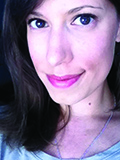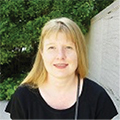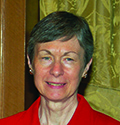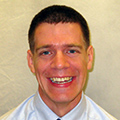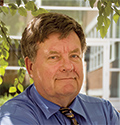Q&A With Educators
We interviewed a handful of statistics teachers to find out who inspired them, where they get their best teaching tools, and what they think is the most challenging part of being a teacher.
Amy Hogan
Statistics and Math Teacher
Math for America Master Teacher
Twitter: @alittlestats
Blog: A Little Stats
What level of education do you teach?
I teach AP Statistics and other math classes in a specialized public high school.
Where do you teach?
Brooklyn Technical High School in Brooklyn, NYC.
What or who inspired you to become a teacher?
When I was a math major in college, I said I never wanted to teach, but I changed my mind once I got a taste. Prior to teaching, I worked as an actuarial analyst. I took on a training role in my company and quickly realized I really enjoy helping other people learn.
Can you describe your day-to-day life as a teacher?
An average teaching day for me: subway to work, teach AP Statistics classes, meet with colleagues for mentoring or common planning, coach my math team, grade and/or lesson plan after school, subway home, go to Pilates class, and then relax with a nice dinner at home.
What has been your most satisfying teaching experience?
The greatest reward, in general, is when my former students tell me about the math and statistics they’re learning in college or doing in their careers. Recently, a former student visited and said, “This semester in college, I derived the Central Limit Theorem using a Fourier transform. So cool.”
What is the most challenging part of being a teacher?
The politics. The negative impact of reduced budgets, changing curricula, and outside influences are becoming more and more of a reality for public high-school math teachers, especially.
How is teaching today different than it was when you first started?
The biggest difference I see is the growing number of open source and open access materials. The increased availability of these resources is especially helpful for public school teachers because it means they can do more with their often-limited resources. Less reliance on cost-prohibitive materials is a win for everyone, sure, but it’s imperative to increase equity in math and statistics education.
What advice would you offer someone who is just starting their teaching career?
New teachers should make sure to find a community of teachers, in their school or elsewhere. I would not be where I am today without the help of very supportive colleagues.
What do you enjoy doing in your spare time?
I am learning R/RStudio, and it’s been a lot of fun. I also love to travel. I enjoy finding great local places to eat and drink in my travels as well as at home in New York City.
You have a great blog, A Little Stats, that offers resources for statistics teachers. Do you recommend any other blogs or books?
Too many to list here! You can see my stats faves on my blog. In general, one of the best resources for AP Statistics teachers is the AP Statistics Teacher Community
Where do you get your favorite lesson plan ideas? What is your favorite teaching resource?
My favorite source of statistics teaching ideas comes from other statistics teachers and professors. The network of stats teaching friends via the AP Statistics community, conferences, and Twitter is an endless source of inspiration for me.
Michelle Everson
Professor and program specialist of statistics at
The Ohio State University
What level of education do you teach?
I teach at the college level.
Where do you teach?
I teach in the department of statistics at The Ohio State University.
What or who inspired you to become a teacher?
My biggest inspiration to become a teacher was Joan Garfield. I started working as a teaching assistant for Joan during the second year in my PhD program at the University of Minnesota, and that experience changed my life.
I wasn’t sure at that time what I wanted to do once I completed my degree. I was shy and introverted. The thought of being a teacher and standing up and talking in front of other people on a daily basis scared me to death. Joan opened my eyes to a world I was unfamiliar with, and her support and encouragement gave me a much-needed boost in confidence. She showed me that activity and discussion have a place in the statistics classroom, and she changed my ideas about teaching and learning. She introduced me to research and scholarship in statistics education and to a whole community of statistics educators.
Joan was one of my biggest cheerleaders while I was a graduate student, and she continued to be a mentor to me after I received my degree.
Can you describe your day-to-day life as a teacher?
Typically, I teach one face-to-face section of our statistical literacy course, and I also teach the online section. I also serve as the coordinator for the course, and this involves supervising 12 or more graduate teaching assistants and lecturers per semester. I’m ultimately responsible for all the students and teaching staff who work with the course, and we often have between 900 and 1,100 students taking the course per semester.
I would say a good chunk of my day-to-day life involves trying to keep up with email! On a daily basis, I generally receive several messages from students, teaching assistants, or lecturers about various course-related issues. I have a weekly meeting with our teaching assistants to talk about what is going on in the course and to plan ahead for future assignments and activities, and it’s not uncommon for teaching assistants to stop by my office at various times each day to ask questions or share some of their experiences. There are two days each week when I have regular office hours, and students from our course might stop in then as well to get extra help or talk about concerns.
I always like to try new things each semester and revise my course materials, and that takes some time each day. I update my lectures with new and timely examples, and I make adjustments to lab activities and homework assignments based on how these assignments worked during the previous semester.
Sometimes, I might attempt a new activity from scratch if we begin to notice our students are struggling with particular ideas and need extra practice with certain concepts. I would love to get to a point where I have all assignments and lectures ready to go at the start of the semester, but I’m usually tinkering with things a little at a time throughout the semester.
If I’m not in the classroom or checking in with my online students, I’m usually planning ahead and trying to stay on top of things. Another part of my job involves handling some of the staffing in our Mathematics and Statistics Learning Center (MSLC). This is a place where students can go throughout the week to get extra help from our graduate teaching assistants with the content in many of our statistics courses, and there are often little things I have to take care of on a regular basis related to the MSLC.
This coming autumn, I will also be serving as a faculty mentor in a special OSU program called the Second-Year Transformational Experience Program (STEP). Through this program, I will work with and meet regularly with a cohort of approximately 15 second-year students, and I’m excited to be able to learn more about their interests and concerns and help guide them through part of their college journey.
What has been your most satisfying teaching experience?
I think I get the most satisfaction when former students get in touch with me, out of the blue, to tell me about experiences they’ve had that remind them of content they learned in my course or to tell me about how much they are using information they learned in the course.
Just recently, a former student stopped by my office to talk about his plans for graduate school, and he told me he is now seeing a lot of what we talked about in our statistics course in journal articles he is reading in his field of study. Another former student sent me a bad graphical display she noticed in a news report because she thought I would appreciate it (and it was a good one).
For me, it is such a wonderful feeling when I can tell students are seeing the value in what we are trying to share with them, even if they might not totally get it until well after the course ends.
What is the most challenging part of being a teacher?
The older I get, the more out of touch I sometimes feel where my students are concerned. I gasp each year when I read the new Mindset List from Beloit College, because the world our students are now living in seems so different from the world I grew up in. I don’t always know what interests my students have, or what types of obstacles they are facing as college students, and I am constantly trying to figure this out so I can do a better job when it comes to engaging and motivating these students.
I teach a course that students have to take, and many of the students don’t necessarily want to be taking the course or see the point of the course. I honestly think that is one of the biggest hurdles I face as a teacher. I work hard to try to get to know my students and find out more about them so I can bring more engaging and relevant examples into the classroom. Finding new and innovative ways to excite and inspire students is definitely a challenge, but it’s one I’ve enjoyed trying to tackle.
How is teaching today different than it was when you first started?
I personally think one of the biggest differences relates to technology and how it has changed what we can do and how we can interact with each other. When I first started teaching, we were not offering online courses, and I had no experience ever being an online student. When we were able to develop our first online courses at the University of Minnesota, in 2004, I was still using a dial-up connection at home, and this greatly affected what I felt I could do in my courses. I didn’t want to share resources my students would not be able to easily download, and I was limited in terms of what I could easily upload from my home computer. There was no YouTube, Twitter, or Facebook when I first started teaching, and students were not spending several hours per day texting.
Now, I find the possibilities to be endless in terms of what we can do within our online classrooms, and I love that it is so easy for us to find and share great YouTube clips with our students. I’ve even experimented with course assignments that capitalize on students’ fascination with social media. I love being able to easily communicate with my students via email, and I like that my interactions with students are not bound to certain hours each week within my office.
I also find that students appear more comfortable now with technology, and savvier when it comes to using technology, and that opens the door for us to use technology in different ways in our classrooms.
What advice would you offer someone who is just starting their teaching career?
I would advise trying to find at least one other person you can collaborate with or share ideas with. If you don’t have someone at your institution, there are so many wonderful people all over the world who are passionate about statistics education. The Isolated Statisticians discussion list is a great place to connect with other educators.
I would also advise trying to go to at least one conference that focuses on statistics education. One of the best ones is the United States Conference on Teaching Statistics (USCOTS). This conference takes place every odd-numbered year. During the even-numbered years, there is the Electronic Conference on Teaching Statistics (eCOTS).
The statistics education community is incredibly warm and welcoming, and I know my own career has been enriched by having opportunities to network with and get to know others in this community.
What do you enjoy doing in your spare time?
When I am not on campus, I’m very happy spending time working around our house. My husband and I have a small hobby farm where we raise sheep, pigs, and chickens. I’ve also recently developed an interest in repurposing old furniture, and I love reading true-crime novels.
Name one or two favorite blogs or books you have read and would recommend to others.
A few years ago, my good friend Ellen Gundlach suggested I read the book My Freshman Year: What a Professor Learned by Becoming a Student, by Rebekah Nathan, and I just recently re-read this book. It’s all about a college professor who decides to apply to college, as a freshman, and live for a year among other freshmen in order to better understand why college students behave as they do. The book is probably slightly out of date now—it was written in 2005—but I was fascinated by what I learned about the modern-day college student, and it definitely gave me some insights as to why some of my own students might act as they do.
Another book I am currently reading is called Cheating Lessons: Learning from Academic Dishonesty, by James M. Lang. It’s filled with ideas about how we can re-think our classroom assessments to extrinsically motivate our students (and, hopefully, in the process, cut down on academic dishonesty).
Where do you get your favorite lesson plan ideas? What is your favorite teaching resource?
Honestly, I get lots of ideas from reading news reports and listening to news radio! I have a long commute to campus, and I often listen to the news as I’m driving. Several news stories have made their way into my lectures and assignments.
I have also found lots of great ideas on the website for the Consortium for the Advancement of Undergraduate Statistics Education (CAUSE) and within the Journal of Statistics Education and the journal Teaching Statistics. Other great resources are my peers; lots of lesson ideas have been born simply by bouncing ideas off of colleagues.
Katherine Halvorsen
Professor, Smith College,
Northampton, Massachusetts
What or who inspired you to become a teacher?
My mother and her aunt were both teachers. It felt to me like the “family business.”
Can you describe your day-to-day life as a teacher?
Teaching classes, meeting with students, serving on committees—both at the college and for the ASA—and working on research projects—alone and with students.
What have been your most satisfying teaching experiences?
Watching students develop mastery in my courses and reading a student’s comment that projects are so much easier when they hand in intermediate reports on a regular schedule, rather than do everything in the last few weeks of the course!
What is the most challenging part of being a teacher?
Teaching students the importance of planning ahead for getting their work done, of showing up prepared, and of working out a plan with me when they can’t do these things.
How is teaching today different than it was when you first started?
Statistics is now a required course for almost all STEM students and many liberal arts majors. It was not a required course when I started teaching. Only curious math majors and some adventurous biology majors took the course.
What advice would you offer someone who is just starting their teaching career?
Join the Statistical Education Section of the ASA and become a grader for AP Statistics. Both groups offer a lot of help to newcomers and experienced teachers.
What do you enjoy doing in your spare time?
Reading, hiking, and traveling.
Name one or two favorite blogs or books you have read and would recommend to others.
James Lang’s Small Teaching: Everyday Lessons from the Science of Learning.
Where do you get your favorite lesson plan ideas? What is your favorite teaching resource?
I read a lot and talk to other teachers.
Mark Ward
Associate Professor of Statistics
Associate Director of Actuarial Science
Undergraduate Chair, Purdue University
What level of education do you teach? Where do you teach?
I have been the undergraduate chair in statistics at Purdue University since 2008. Purdue has one of the largest undergraduate programs in statistics in the United States. I am also associate director for actuarial science and the faculty adviser for Purdue’s ASA Student Chapter. I am the PI for the NSF-funded Statistics Living Learning Community. I have an active research program that includes both graduate students and undergraduate students.
What or who inspired you to become a teacher?
My mom recently retired from a career as an elementary school teacher. Her work with students always inspired me. When I was in middle school, I spent a significant amount of time reading to my peers who couldn’t read. I experienced the joy of helping others learn, so I decided to devote my life to learning and helping others learn.
I first learned about probability and statistics from Ron Selby, my high-school mathematics teacher. He had an inspiring style of conveying ideas about mathematics. My college professors Don Bonar and Joan Krone were particularly motivating mentors.
I also am inspired by my wife, Laura. Our children learn at home, rather than going to school. I love seeing how my wife and children interact with each other. I learn a great deal from Laura and our children, and I feel fortunate to be married to the smartest person I know.
Can you describe your day-to-day life as a teacher?
I spend a great deal of time with undergraduate students. Last year, I requested to move to the academic advising floor in our building because I talk with students and their advisers a lot. Students are constantly hanging out in my office. I try to maintain a comfortable research environment, where students can ask questions and push themselves to learn more than they might on their own.
I am a morning person, so I like to arrive early to campus, have my courses and seminars in the early morning, and go home to my family in time for dinner.
What has been your most satisfying teaching experience?
The Statistics Living Learning Community (STAT-LLC) has been the most satisfying experience for me. Twenty sophomore undergraduate students participate per year. They take their probability theory, statistical theory, and data analysis courses together as a cohort. They all live together on the same floor of the same residence hall, and I am their faculty fellow (a mentor role). They all have a full 12 months of research as sophomores.
We also have professional development seminars, visits with alumni, travel to conferences, etc. Quite a few of them came with me to JSM in Baltimore this summer. Our first cohort of students just graduated from Purdue this spring, and I miss them already.
The STAT-LLC has afforded me the opportunity to learn a great deal from our sophomores. In particular, I am always trying to better understand how to connect the disparate parts of their time spent on a college campus. I encourage my colleagues to do many things with students outside the classroom and office.
Every year, for instance, my wife, kids, and I go camping with the students, and we also feed them in our home. The students get a better understanding of the lifestyle of a faculty member as a result. I also eat with the students in their dining courts on a daily basis.
I think the more students know about the statistics profession, the more they are prepared to experience the joys and benefits of spending one’s life working in this area.
What is the most challenging part of being a teacher?
I am not a fan of assessment. I prefer to focus on learning, rather than assessing.
How is teaching today different than it was when you first started?
Many learning environments include online components and group work. This will be my fourth year in which I conduct all my own courses in an “active learning” style.
The students in my probability theory course learn by working on problems in groups, rather than listening to me lecturing in class. I have created hundreds of videos, notes, and exercises with solutions to aid them in learning the material in between class sessions. The students in my data analysis course learn by working on data-driven projects, also in group settings.
I find that active learning promotes better long-term understanding. It also affords the opportunity for students to go deeper in their learning. By not spending a class session lecturing, I have more time to talk with students individually or in a group. It enables us to connect with the material in a more meaningful way.
What advice would you offer someone who is just starting their teaching career?
Be open minded with the learning environment you offer to students. Try to adopt your favorite methods from the peers you respect the most and find the way you and your students enjoy interacting the most.
Students appreciate faculty who wholeheartedly devote time to learning. Students also love to do research with faculty members. Research offers a great way to convey one’s appreciation of the field to a student. Research and learning with students can make the life of a professor a sheer pleasure all the time. It doesn’t feel like work when you truly love what you do.
What do you enjoy doing in your spare time?
Most of my time away from Purdue is consumed by time with my family. We particularly enjoy camping at Indiana state parks, as well as playing board games together. My hobbies including playing guitar (and occasionally harmonica) at our church. I also enjoy reading poetry.
Name one or two favorite blogs or books you have read and would recommend to others.
I recommend the blog Stats + Stories. My favorite book is True Love, by Robert Fulghum. It was published 20 years ago, when I was in college. I love how it describes the real-world aspects of love in its many forms.
Where do you get your favorite lesson plan ideas? What is your favorite teaching resource?
Ellen Gundlach and I wrote a book on probability together. She is a constant source of ideas for problems and activities students will love. We worked hard to create hundreds of exercises in our book that would be motivating for students. I also give her all the credit for introducing me to the concept of “active learning” and helping me transition all my own courses to this model.
Chris Olsen
Visiting Professor
Grinnell College
What level of education do you teach? Where do you teach?
After four years in middle school and 35 years in high school (interrupted by a stint as an “assessment specialist” in Cedar Rapids, Iowa), I am now teaching statistics at Grinnell College in Grinnell, Iowa.
What or who inspired you to become a teacher?
My inspiration was a terrific math teacher, Mr. Larsen, in high school. A wonderful person and a wonderful man. When I went to college, I thought I wanted to be an engineer and build bridges in South America. I knew nothing about engineering, bridges, or South America, but all my friends were going to college, so I figured I should also. A quick discovery of a singular inability to do engineering graphics (by hand in those pre-computer days) led to a quick decision—I wanted to be like Mr. Larson.
Can you describe your day-to-day life as a teacher?
My day-to-day life as a teacher begins on my commute, listening to National Public Radio and catching up with the world. I have pen and paper at hand in case there is a story about some new study that might be a good example of statistics. If there is one, I try to track it down when I get to the office; with any luck, it will reinforce my classroom assertion that statistics is not only relevant, it is constantly relevant!
My day in the office starts with checking email from students to see what problems have developed in the interim and getting ready for the day’s classes (think caffeine here).
The best part of the day is my classes and the excitement interacting with young people. Between classes, I do the usual teacher things: prepare for the next class, re-write lessons and activities that I am—as they say in Casablanca—shocked(!) to discover need improvement. Then, at the end of the day, I head home with NPR (see above).
What has been your most satisfying teaching experience?
My most satisfying teaching experience occurs when the expressions on the faces of my students evolve from quizzical uncertainty to tentative understanding to (finally) that smiling countenance that says, “I have this nailed.” As can be imagined, this transition is not universal and does not necessarily happen in one day.
To change the question a bit, my most heartwarming teaching experience occurs when I hear from former students who have discovered (sometimes with much surprise) they actually use statistics in their day-to-day professional lives.
What is the most challenging part of being a teacher?
For me, the most challenging aspect occurs when a student is struggling and I need to find a way to present the material differently, not just louder. I get stuck on those phrases that make sense to me, but don’t translate well to those just beginning their journey through statistics. Different words? Different pictures? Different analogies? Different examples? I suppose variability is the heart and soul of statistics, but variability in students’ understanding is a challenge indeed!
How is teaching today different than it was when you first started?
The salient difference is due to technology. The ready availability of calculator and computer has revolutionized what we can do, perhaps without a companion revolution in our understanding of what we should do. The graphic capability of these tools is breathtaking. It allows us to bring statistics to a much larger audience, and that larger audience to better utilize statistics. The power of statistical software has eliminated the drudgery of calculation and graphing, but cannot speak to the important issues of sampling on the front end and enlightened analysis on the back end.
I have always tried to find statistically interesting data sets from a variety of fields, but now I think it is increasingly important to discuss the non-computation non-graphical aspects of wrenching knowledge from data: What is the source of the data, and what meaning and insight can be gained from the results presented by the software?
What advice would you offer someone who is just starting their teaching career?
Read in journals outside the realm of statistics and digest both what and where statistics are used. Be prepared (and appreciate) that many of your students in elementary classes know more about their fields of study than you do. Learning is a lifelong activity, and your students will help keep you up to speed about that world beyond theoretical statistics.
What do you enjoy doing in your spare time?
Spare time. Hmm. I’ll have to look into that concept. I mostly enjoy reading (plugging those vast holes in my knowledge) and computer programming (my “hobby”).
Name one or two favorite blogs or books you have read and would recommend to others.
Most of my casual reading is cheap, trashy murder mysteries, but occasionally, by chance, I stumble into some more literary tomes. I can’t decide on one or two, so I will offer three.
The Lost: The Search for Six of the Six Million, by Daniel Mendelsohn, is a fascinating weaving of Old Testament brother-brother relationships and his search
for information about his family lost in the holocaust.
To everyone I see recently, I have been recommending Killers of the Flower Moon: The Osage Murders and the Birth of the FBI, by David Grann. That title says it all; I could not put it down.
In the fiction category, it would be tough to beat Louise Erdrich’s The Last Report on the Miracles at Little No-Horse. Not to give anything away, long story short, it is a tale about a woman who assumes a priest’s identity and functions in that role for many years at a Native American reservation. These three are the best I have read since Catch-22.
Where do you get your favorite lesson plan ideas? What is your favorite teaching resource?
My favorite ideas basically come from (a) NPR, (b) The New York Times Tuesday Science section, and (c) trolling libraries and JSTOR to find real data for real students.
Truth be told, I enjoy reading about our fascinating world and I’m lucky to be able to claim I’m “planning” when on these little excursions into what we used to refer to as the stacks.

